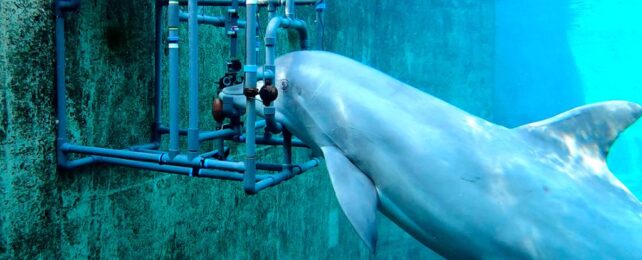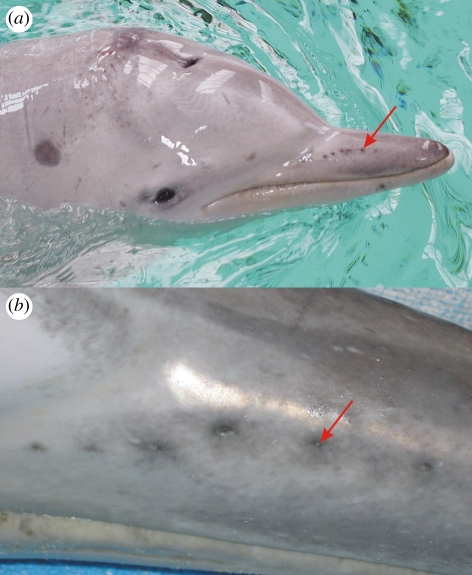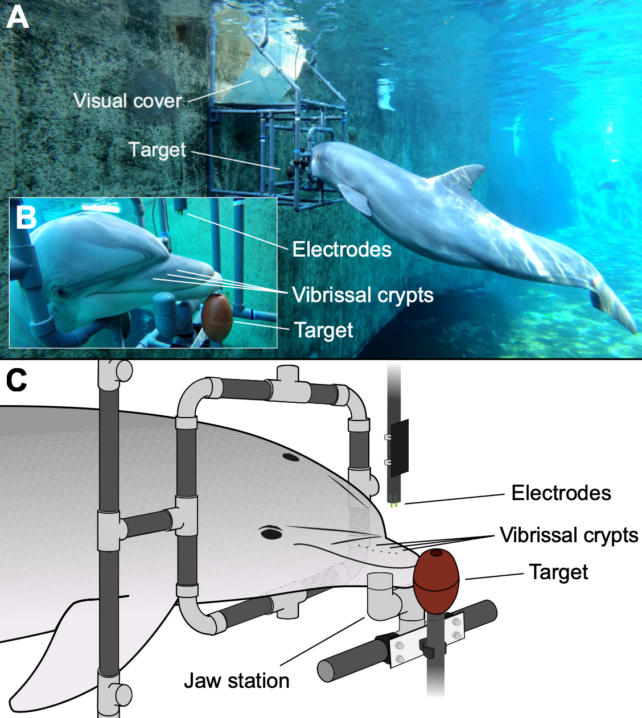Dolphins Reveal a Mysterious Hidden Sense: They Can Detect Electric Fields
 Dolphin rests head on bar to detect electric current. (Tim Hüttner)
Dolphin rests head on bar to detect electric current. (Tim Hüttner)One of the most well-studied marine mammals in the world has been secretly harboring a superpower sixth sense.
Two captive bottlenose dolphins (Tursiops truncatus) have now proved to researchers at the University of Rostock and Nuremberg Zoo in Germany that they can reliably sense weak electric fields in the water with their long snouts.
The discovery hints at the possibility that some marine mammals really can sniff out the electric currents of small prey buried in the sand. They might even use the skill to sense Earth's magnetic field.

To date, only one other 'true' placental mammal on Earth has been found to possess electroreceptors. Little more than a decade ago, scientists demonstrated that the common Guiana dolphin (Sotalia guianensis) evolved its own unique system of electroreception – one that is inherently different to fish, amphibians, and monotremes, like platypuses and echidnas.
Experiments now suggest that adult bottlenose dolphins and Guiana dolphins can both do something oddly similar with a line of sensitive pores on their snouts, called vibrissal crypts. These little holes used to hold juvenile whiskers, and they are extremely sensitive.

In experiments, bottlenose dolphins were able to use these ex-whisker pits to sense very weak electric fields as low as 2.4 and 5.5 microvolts per centimeter – a detection threshold that the researchers say is "in the same order of magnitude as those in the platypus" and also similar to Guiana dolphins.
The recent results were only gathered from two captive bottlenose dolphins at Nuremberg Zoo, named Dolly and Donna, so further experiments are needed to figure out how these creatures actually use this sense in the wild.
Nevertheless, there's reason to suspect electroreceptors play a role in dolphin foraging.
In the 1990s, researchers noticed bottlenose dolphins diving headfirst into the sand (sometimes all the way up to their pectoral fins) before swimming off with fish. The foraging strategy, called 'crater feeding', was thought to work mainly via echolocation, and yet new evidence suggests that electroreception may also play a role in the skill.
In the water, all organisms produce electric direct current fields (DC), and when a fish is breathing via its gills, these fields can turn into pulses of alternating currents (AC).
Passively sensing both DC and AC fields could allow bottlenose and Guiana dolphins to find small prey hiding in the sand.
In experiments, scientists in Germany trained Dolly and Donna to rest their snouts against a metal bar with electrodes in the water.
Once the dolphin was settled, the experimenter presented a randomly generated stimulus, either an electric stimulus or nothing.
The dolphins were trained to swim away from the bar within five seconds of sensing an electric field. If they didn't sense anything, they stayed in the same spot for at least 12 seconds.

Over several days of experimentation, researchers reduced the strength of the electric field presented.
When they presented DC electric fields under 125 microvolts a centimeter, Dolly and Donna figured out how to sense the signals with 90 percent accuracy.
At just 5.4 microvolts a second, Dolly's performance dropped to 50 percent. Beyond that, researchers say the dolphins became reluctant to continue the training and their performance plummeted.
Donna still detected electric signals at 3 microvolts a centimeter with an accuracy of around 80 percent, and yet her performance at 2 microvolts dropped to 33 percent.
Even when the dolphins were exposed to pulsing electric fields, Dolly and Donna could pick up on signals as weak as 28.9 microvolts and 11.7 microvolts per centimeter, respectively.
For the weakest electric fields, scientists noticed Dolly shaking her snout back and forth "as if searching for an electric stimulus".
This 'wiggle' is also commonly seen during crater feeding.
The movements could potentially enhance prey detection, similar to how a platypus wiggles its own bill back and forth when looking for a meal with its electroreceptors
"Taking these calculations into account," write the researchers, "thresholds determined for bottlenose dolphins in the present study would indicate that they can detect the same fish species considered for sharks at a distance of 3–7 cm."
Echolocation, by comparison, allows dolphins to detect solid objects in the sand as deep as 30 centimeters down. But crater-feeding buries the dolphin snout and eyes, making objects detected by echolocation possibly limited due to reverberation and scattering effects.
Electric senses could be more reliable. They could also help the creatures orient themselves along Earth's magnetic field.
If a dolphin slowly swam through a weak area of Earth's magnetic field, researchers explain, it could theoretically generate a weak electric field of around 2.5 microvolts a centimeter across their body.
Just enough to detect.
The study was published in the Journal of Experimental Biology.
No comments:
Post a Comment